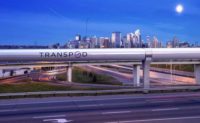AECOM, EllisDon Push $7.2B Investor-Funded High Speed Rail Proposal

A long-anticipated effort to build Canada's first high speed rail that was launched last month in a $7.2-billion privately funded proposal by Canada's EllisDon and U.S. giant AECOM, already is fielding investor interest, says an executive of the Mississauga, Ont.-based contractor.
The firms' partnership—Prairie Link High-Speed Rail (HSR) Partners—said it has inked an agreement with Alberta Transportation to build an estimated 200-mile fast rail network connecting the provincial cities of Edmonton, Calgary and Red Deer in what would be the nation’s first high-speed rail line.
While the agreement lays the foundation for cooperation between the major Canadian construction firm, the U.S. project design and management giant and the provincial transportation agency, the memorandum of understanding does not include a financial commitment by Alberta—with the project to be funded through the private sector.
“We have been in talks with some investors already,” said Colin Hill, vice president of EllisDon's civil west division and a Prairie Link board member, in an email. “At this time, we are not disclosing where commitments have been made but I can tell you that we have invested considerably in the project already.”
Two Years of 'Pre-Development'
The Prairie Link partnership has at least two years of “pre-development” work ahead before it can break ground on the project, according to Hill.
The development team will focus on gaining various environmental and other regulatory approvals it needs to move forward. The process will include consultation with “our Indigenous partners,” Hill said, alluding to Canada’s First Nations’ populations, who have become more crucial in Canadian permitting efforts.
The Prairie Link team will also work with “key stakeholders” that include officials in the destination cities, Calgary International Airport, Edmonton International Airport, and Alberta government, Hill noted.
The project will not be a P3, or public-private partnership, with EllisDon and AECOM having submitted the proposal for the privately-funded venture through Alberta’s Unsolicited Proposal process.
The high-speed rail line would need 4 million passengers per year, a number that Prairie Link executives contend is realistic given the current population of the province and more demand for private and business rail travel, according to media reports.
The project’s promoters have stated they are looking to Europe and Japan as their model for the line's train technology, with speeds ranging as high as 248 miles per hour. TGV trains in France can attain speeds of more than 217 miles per hour.
As part of its initial work on the project, Prairie Link plans to hire an engineering firm to help hammer out the project's economic and business case.
But Prairie Link faces some formidable hurdles, said Ryan Katz-Rosene, an assistant professor of political studies at the University of Ottawa who has been tracking the high-speed rail debate, which he noted has been ongoing for half a century.
Hurdles Are Ahead
One big problem has been that estimated costs for high-speed rail projects have had a tendency to rise as feasibility studies get underway, causing federal and provincial governments to get cold feet.
That may be less of a problem with the Alberta proposal, which would be privately funded, although investors are also susceptible to sticker shock.
“The problem with any sort of massive infrastructure project is that the costs always spiral out of control,” Katz-Rosene said. “That has been a fundamental problem.”
There is also a very “car-friendly” culture in Alberta, he said, which could also pose challenges to getting people to shift their modes of transportation.
In addition, as much as the environmental imperative to reduce carbon emissions has grown, simply rolling out high-speed rail in Alberta may not necessarily be an unalloyed win, according to Katz-Rosene.
The province still relies on coal-fired power plants, so the increase in electricity needed for the new rail line and additional carbon emissions may offset the environmental benefits of switching to rail, he said.
That said, Alberta high-speed rail proposal has some strong catalysts
“The one place in Canada where it would make sense is the Calgary-Edmonton corridor,” Katz-Rosene said. “It is relatively straight and short and there is interest from the government in power, the lack of which has been one of the main factors that has always killed these projects.”
But the high-speed rail project also faces competition from an alternate form of high-velocity transportation. Toronto-based TransPod inked its own memorandum of understanding last year with authorities in Alberta.
The provincial government is now working with the company to find land on which to build a test 12-mile track for an elevated, electromagnetic hyperloop that could link Edmonton and Calgary. TransPod’s project would ferry passengers between the two cities as speeds of more than 372 mph and reduce travel time to just 45 minutes.
It is not clear at what point Alberta officials will decide on one of the high speed projects.
Separately, in another big rail deal for the Western Canadian province, Invest Alberta Corp. has signed a deal with the federally-owned Canada Infrastructure Bank for a 93-mile rail line from the Calgary airport through downtown and west to the Banff mountain resort.
The bank said it would weigh plans to pick up half the cost for that $1-billion project.




